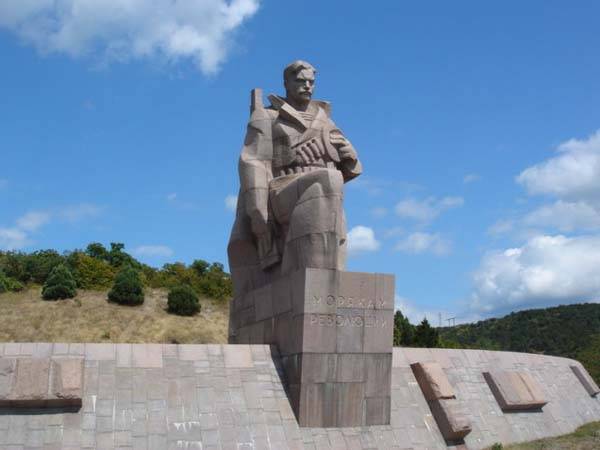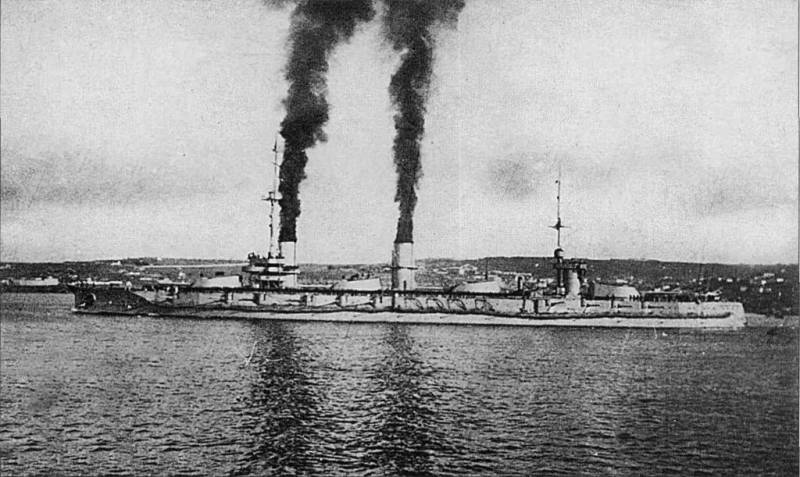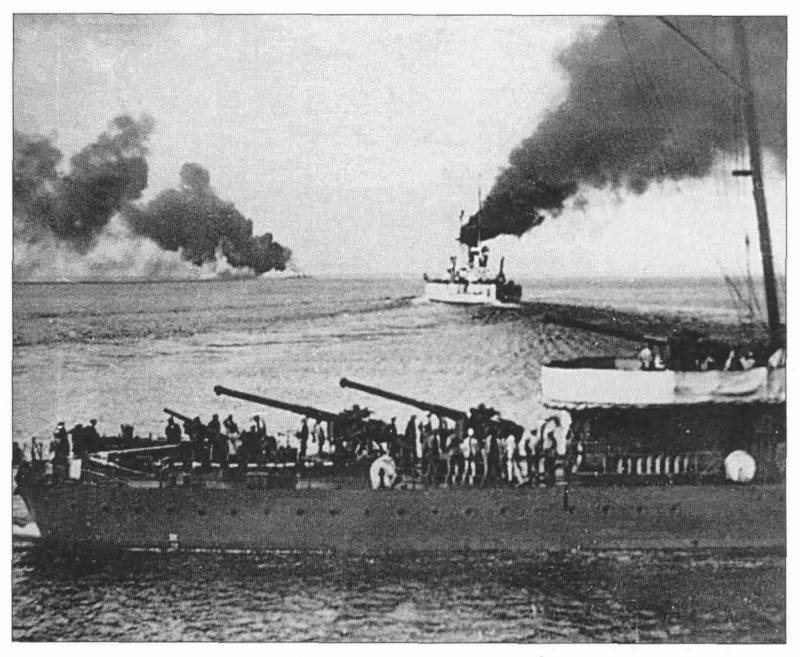"I die, but I don't give up." How the Black Sea Fleet Perished
prehistory
18 February 1918, the Austro-German troops launched an offensive on all fronts. Young Soviet Russia did not have an army to stop the enemy. 3 March 1918, the Soviet delegation signed the Brest Peace. Russia pledged to immediately conclude peace with the Ukrainian People’s Republic (the Central Rada fell under the Germans) and recognize its peace treaty with Germany and its allies. Thus, Soviet Russia was losing Western Russian lands — the Baltic States, White and Little Russia. And the new boundaries were not clear. Moscow hoped for the imminent collapse of the German bloc and revolution, which would allow Brest to be canceled.
Meanwhile, the German troops entered Bravo in Kiev, and the Austrians occupied Odessa. The Germans quickly became convinced that the Rada did not represent anything, and the “troops” of the UPR had only a couple of thousand former soldiers, idlers and adventurers. Therefore, on April 29, “election” of Hetman P. Skoropadsky took place, which was to form a more effective colonial administration. And the Central Rada was dispersed by a German guard without a single shot. The UPR was replaced by the “Ukrainian State” - another ephemeral “state”. Skoropadsky tried to consolidate his position: a serduchny division was formed (Serdyuk from Tur. Sürtük "conductor, spy" or "angry, angry", guard of the hetman), the division of General Patnev in Kharkov, the 1-I infantry division created by the Austrians of the United States. in Vladimir Volyn, as well as several security and border hundreds. In addition, the hetman began to form and white troops.
The Austro-German occupiers took decisive measures to restore order in Little Russia (Ukraine). Landowners returned the land seized by the peasants, inventory, and livestock. Punishers carried out mass executions and repressions. However, this did not reassure the population, but only embittered him. Guerrilla and banditry adopted a new scale, which was not yet at the Central Rada. The whole gangster "armies" acted in Ukraine, like the formation of Makhno's father. The gangs of Green, Struk, Sokolovsky, Tyutyunin, atamanshi Marousi, etc., became very famous.
Fleet care in Novorossiysk
According to the agreement with Kiev, the Germans in April entered the Crimean peninsula. At the same time, the uprising of the Crimean Tatars began. The government of the Soviet Republic of Taurida fled from Simferopol. Some members of the government headed by A. Slutsky were captured in the Alupka area and executed.
The Sevastopol fortress at that time was one of the most powerful in Russia. In Sevastopol there were dozens of serfs and naval guns, there was a huge ammunition. Even without the support of the fleet, the fortress could withstand the enemy for a long time. And with the presence of the Russian fleet dominating the Black Sea, the capture of Sevastopol was almost impossible. But by this time the old army and navy in Russia had completely decomposed and collapsed, and the new armed forces had just begun to form. Therefore, there was no one to defend the city. Revolutionary and anarchic "little brothers" beat and bruised the bourgeoisie with pleasure, killed the officers, but in principle did not want to fight. Some thought where to escape, and others how to become “Ukrainians” and negotiate with the Germans.
March 27 Maritime General Headquarters (MGSH) sent the Central Committee of the Black Sea Fleet (Tsentroflot) a telegram on the need to transfer ships to Novorossiysk, so that the Germans did not fall into the hands. At the plenary meeting, Tsentroflot accepted the proposal of the Bolsheviks to immediately prepare the base in Novorossiysk, and bring the fleet to combat readiness as soon as possible. It was decided to staff only new destroyers, one cruiser and dreadnought battleship Volya (formerly Emperor Alexander III) and Free Russia (Empress Catherine II). The old ships due to the development of technical resources and lack of personnel remained in Sevastopol in storage.
As a result, a situation in prison released the former fleet commander Rear Admiral Mikhail Sablin. To save the fleet from being destroyed by the Germans, he ordered the red flags to be replaced with Ukrainian ones, and not wishing to do so before leaving the harbor before midnight, with the result that almost all 29 of April about midnight left and in the morning 1 reached Novorossiysk safely. Attempt by Sablina to negotiate with the German General von Koshem on behalf of the "Ukrainian fleet" did not lead to success. The Germans came close to Sevastopol and Sablin ordered the rest of the fleet to leave. The combat core of the fleet is gone: two dreadnought, the destroyers Kerch, Kaliakria, Shrill, Ardent, Loud, Hasty, Live, Lieutenant Shestakov, Lieutenant-Captain Baranov, Gadzhibey "," Hot "," Strict "," Sharp-witted "and" Swift ", auxiliary cruiser" Troyan ", 65 motor boats, 8 transports and 11 tugs.
During an exit from a bay the ships were fired by Germans from the tools established ashore and "Free Russia" received insignificant damages. The destroyer "Wrath" by mistake engine room ran aground and could not escape. Submarines and small ships returned to the South Bay. In Sevastopol, six battleships remained, two cruisers and other ships, many of which were defective and did not have personnel. The captain of 1 rank M. Ostrogradsky was instructed to prepare the destruction of ships not capable of transfer. Because of the panic and disorder in the port, only the Zavetny destroyer was destroyed. Ostrogradsky ordered the Ukrainian flag to be raised on ships unable to move.
Russian ships left on time. On the night of May 1, the German battleship Geben and the light cruiser Hamidie took up positions in front of Sevastopol. More 1916 and at the beginning of 1917, they would have become easy prey for the Sevastopol squadron, but now the Russian fleet has lost its combat capability. 1 May German troops entered Sevastopol. 2 May “Goeben” entered Sevastopol. The Germans raised the German flags on the Russian ships and appointed the captain of Ostrogradsky "the sea representative of the Ukrainian state." Ostrogradsky became naval minister of the hetman, and then moved to the white fleet. But neither Ostrogradsky nor the “Ukrainian Power” in Sevastopol had any real power. All controlled by the German Admiral Hopman. The Germans staged an unceremonious robbery of the property of the fleet and fortress (looting and looting flourished throughout the Crimea and all the occupied areas). The Prut cruiser (a former Turkish ship) was handed over to the Turks and taken to Constantinople.
Battleship "Free Russia" ("Catherine the Great")
The death of the fleet
The situation in Novorossiysk was alarming. Novorossiysk port was not adapted for the long stay of such an impressive squadron. Sablin received a telegram from German Field Marshal Eichhorn from Kiev demanding the return of the ships to Sevastopol, where to hand them over to the Germans. The German command demanded the transfer of the fleet from the leadership of the Soviet Republic, threatening with a further offensive on all fronts. German reconnaissance aircraft began to appear over Novorossiysk, and their submarines at sea. The city anxiously waited for the further advance of the German troops already occupied Rostov and Kerch. German troops really planned to take Novorossiysk. It was rumored that the Germans landed the landing corps in Taman, the fleet was demoralized and could not resist: there were constant meetings, the sailors deserted. Sablin went to Moscow to save the fleet and restore supplies, leaving the commander of the "Freedom" commander, captain of 1 rank Alexander Tikhmenev.
The head of the Soviet government, V. Lenin, did not intend to hand over the fleet to the Germans, but Russia could not fight either. On May 24, Chief of the Marine General Staff E. Behrens presented a report to the head of the Soviet government to Lenin, which said: “Germany wishes to take control of our fleet at any cost. Further attempts on our part to resolve the issue by negotiations under the above conditions give only Germany the opportunity to gain time and obviously will not lead to anything. Our vessels in Novorossiysk will fall into the hands of not even Ukraine, but Germany and Turkey and will create these in the future their domination on the Black Sea ... All these conditions show that the destruction of ships in Novorossiysk must be done now, otherwise they will undoubtedly and probably completely or partially fall into the hands of Germany and Turkey. Lenin signed on the report of the Marine General Staff: "In view of the hopelessness of the situation, proved by the highest military authorities, the fleet must be destroyed immediately." In May, the secret directive signed by Lenin was sent to the commander and chief commissar of the Black Sea Fleet 28 in May with the order "to drown all the vessels of the Black Sea Fleet and commercial ships in Novorossiysk." At the same time, in order to gain time, the Council of People's Commissars sent an open telegram to the fleet about the need to transfer the ships to the Germans. And encrypted - Tikhmenev, with a categorical requirement to flood the fleet.
Later, in the years of the victory of "democracy", the myth was created in Russia that the Bolsheviks, by malicious intent, destroyed the fleet. In fact, the Soviet government complied with the recommendations of military experts (officers of the former Tsar's fleet), who feared strengthening the fleet of Germany and Turkey at the expense of Russian ships. It should be remembered that the final fate of the fleet was not decided by Lenin's telegram. At this time, the farther from the center, the greater the anarchy and partisan. In particular, the chairman of the Kuban-Black Sea Republic, A. Rubin, demanded not to execute the decision of the central government to flood ships and promised to take over the supply of the fleet. Also, the delegation of the republic promised to resolve the issue of allocating ground units for the defense of the city, but eventually left and did not appear again. Fleet sailors made their own decisions. Tikhmenev revealed to the teams the content of the instructions of Moscow and the following days passed in a general discussion of the future fate of the ships. Deciding what to do: let the ships to the bottom or return to Sevastopol? 14 June passed a vote: 939 sailors voted for Sevastopol, 640 - for flooding, about 1000 - abstained. About dreadnoughts distribution of votes was as follows: on the “Will” for the return - 360, for the sinking - 140; on “Free Russia” for the return - 350, for the drowning - 340.
On July 15, Commander Tikhmenev announced that the referendum had won the bid to go for Sevastopol, discarding the abstentions (demanding to wait or fight). Most of the officers supported him, the lesser, led by the commander of the destroyer "Kerch" senior lieutenant Vladimir Kukel (grandson of Admiral Gennady Ivanovich Nevelsky), considered the surrender of ships to the Germans as the highest disgrace, and continued to agitate for flooding. They evaluated the voting results as “majority against submission”. Tikhmenev ordered to begin preparations for the departure. Teams of some destroyers, in particular the Ushakovsky Division, ignored the order, others began to prepare, but expressed doubt in this decision. Many sailors, opponents of the transition to Sevastopol, left the ships at night. On the morning of June 16 was ordered to breed pairs, which many destroyers did not perform. Having learned about the decision to go to Sevastopol, the townspeople flooded the port and the piers, urging the teams to stay. June 17, fulfilling the order of the commander to follow to the Crimea, six destroyers and the battleship "Volya" began to go on an external raid. Nine destroyers refused to leave. The “Free Russia” battleship also remained, unable to separate the pairs. When all the departed ships began to anchor on the outer roadstead, after them on the destroyer “Kerch” a signal was raised: “To ships going to Sevastopol: shame on the traitors of Russia”.
Representatives of the Soviet government Glebov-Avilov and Vakhrameyev arrived at Volya, but could not convince Tikhmenev to scuttle the ships. He appointed care on 10 evenings, trying to divert also "Free Russia". But attempts to replace her engine team with officers and civilian craftsmen failed. At night, the Tikhmenev compound — Volya, the destroyers Daring, Hasty, Restless, Ardent, Living, Hot — in tow at the auxiliary cruiser Troyan and the floating base of high-speed boats Cross, departed in Sevastopol.
The battleship Volya leaves Novorossiysk for Sevastopol. In the foreground - the destroyer "Kerch"
By the morning of June 18, the full crew (about 130 people) remained on Kerch, with general disarray and wobbling, Senior Lieutenant Kukel managed to save most of his ship's crew. On the "Lieutenant Shestakov" were collected up to fifty sailors from different ships, on the rest of the destroyers - less than 10 people on each. It was decided to use the "Lieutenant Shestakova" as a tug, and "Kerch" - as a torpedo. The destroyer "Lieutenant Shestakov" began to tow the ships to the site of flooding. The Kerch torpedo sank Fidonisi, after which all the other ships were sunk by the discovery of the Kingston and the undermining of key mechanisms. With the signal on the mast "I die, but I do not give up," one after another they hid under the water.
It was the turn of the battleship "Free Russia". With five cable destroyers, Kerch fired two torpedoes around the ship: one exploded under it, the other passed by. The battleship kept afloat, only a column of black smoke rose above the conning tower. The third torpedo, although it landed in the stern of the ship, did not receive significant damage as a result, roll and trim were missing. And after the explosion of the fourth torpedo in the area of the aft turret of the main caliber (305-mm guns), the battleship still did not sink. The fifth torpedo, aimed at the center of the ship, suddenly turned back. And only the sixth projectile completed the case. June 19 and Kerch were flooded at the Kadosh lighthouse near Tuapse. His latest message is: “To everyone, to everyone. He died by destroying those ships of the Black Sea Fleet, who preferred the death of the disgraceful surrender of Germany - the destroyer "Kerch". After the sinking of the destroyer, Kukel reached Astrakhan, where he joined the ranks of the Caspian Flotilla.
The fleet that had gone to Sevastopol was transferred to the Germans. 19 June "Will" and other ships came to Sevastopol. At the request of the Germans, the ships were delivered in Streletskaya Bay of Sevastopol. Crews sent ashore, ships partially disarmed. By early July, on some ships raised German flags. First of all, the Germans captured the floating workshop "Kronstadt", displacing 16400 tons. In fact, it was a floating factory. Subsequently, Wrangell will sell it to the French, and he will serve in the French Navy under the name "Volcano". The cruiser "Memory of Mercury" Germans will turn into a barracks. The Germans will deploy the destroyer R-10 (formerly “Sharp”), the submarine, then the destroyers “Happy” and “Captain Saken”.
After the defeat of Germany in the First World War, the ships came under the control of the Entente. They transferred them to the White Army, and many ships returned to Novorossiysk, and later became part of the Russian squadron under the command of Rear Admiral M. Kedrov. The White movement was joined by Tikhmenev and Sablin. The battleship Volya headed the White Black Sea Fleet and was renamed General Alekseev. After the defeat of the whites, the ports of Crimea left a whole white fleet: one dreadnought - General Alekseev (formerly Emperor Alexander III), one old battleship, two cruisers, ten destroyers, four submarines, twelve minesweepers, 119 transports and auxiliary vessels. France has designated the Bizerte base in Tunisia as the base for the Wrangel fleet. The entire 33 pennant got to Bizerte. And the rest of the white court simply sold. A little later, they sold half of the ships that came to Bizerte. The sale of fleet remnants dragged on until the 1922 year. Due to the huge losses inflicted by the German submarines on the Allied merchant fleets, the demand for transport ships was extremely high. Russian tranporta, passenger ships “Dobroflot” and ROPiT (Russian society of shipping and trade), icebreakers, craft workshops, tugs were literally a great success. Warships were not in demand - the war was over and demobilization and reductions were going on in all combat fleets. However, the guns and ammunition sold all to the last barrel and projectile.
In the Soviet Union, they remembered the feat of the Black Sea sailors who entered in spite of the traitors-commanders. In 1980, on the 12 kilometer of the Sukhumskoe highway of Novorossiysk, the Monument to the sailors of the revolution “I die, but not give up!” Was opened by sculptor Tsigal and architects Belopolsky, Kananin and Havin. On the far side of the road stands the 12-meter-high granite monument of a kneeling sailor. On the sea side there is a cube with a thank-you text and a “I die, but not giving up!” Signal inside, as well as ship pointers with direction and distance to the sites of their flooding with an accuracy of one hundredth of a mile.

Monument to the sailors of the revolution "I die, but I do not give up"


Information